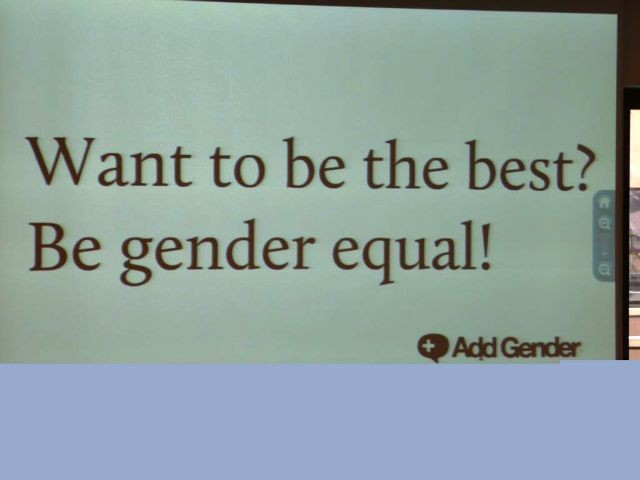|
Two types of discrimination The gender segregation on the labour market means that there may be two types of discrimination in the determination of salaries: As the roles of women and men have been seen as different throughout history and only men have been the ones who had to provide for their families, the income of a woman is still considered secondary, which explains why they are paid less. This attitude remains irrespective of the fact that the employment rate of women has been remarkably high (67%) for some time now. As a result of these attitudes, employers pay a female employee less than a male one even if their tasks are the same or equivalent. Reconciliation of private and professional life The second plenary session highlighted the difficulties in reconciliation or private and professional life. Professor of Sociology of the University of Iceland Ingolfur V Gislasson highlighted an interesting fact: a woman's decision to work depends on how happy the woman is with her partner's contribution to housework. The right decision in working life can never be achieved if men don't increase their participation in housework. This would benefit all of the parties involved - children, men, women and the labour market. Basically, everyone would be a winner. There are also big expectations regarding the reaction of the state. Employers and families do not behave and make decisions in a vacuum. National structures have a significant impact on their conduct. Estonian women have a bigger housework burden than men. The results measured in 2010 indicated that a woman loses income after every birth while the income of men tends to increase instead. Norwegian laws Arni Hole, the Director General of the Royal Norwegian Ministry of Children, Equality and Social Inclusion, first talked about voluntary gender balance in the 1970s in relation to introducing gender quota. The requirement introduced that both genders must be represented by at least 40% in the elected management boards of private limited companies (which are often listed at the stock exchange) was introduced in 2006. Many top business managers in Norway now say that they used to be against the quotas, but they now believe that the law has been effective and good. She also introduced paternity leave in Norway. A quota for fathers was established in the paternity leave plan by law in 1993. From July this year, 12 weeks are reserved for the father and they cannot be transferred to mothers. Policy recommendations The policy recommendations regarding the reduction of the gender pay gap are as follows: Politicians admitted that similarly to other European countries, Estonia has the laws that prohibit discrimination and demand that people are paid equivalent salaries for equivalent jobs. However, the gender pay gap in Estonia is very large in Estonia despite the equal treatment requirements. This means that the law is not implemented and supervision is insufficient. Merle Kuusk, who deals with social and political issued in the Nordic Council of Ministers' Office in Estonia, participated in the gender pay gap conference and wrote the overview of the conference. |
||
|
IMPORTANT LINKS: |
||
The gender pay gap in Estonia is unjustified
|
The study also pointed out the factors that are not among the causes of the gender pay gap, such as the person's specialty or education. One of the reasons for the unexplained gender pay gap may be the fact that some significant indicators (e.g. a more detailed division of positions and economic sectors, the actual abilities of people and their contribution at work, etc.), which are among the causes of the gender pay gap in Estonia, were not included in the analysis. However, it may also stem from the discrimination against women on the labour market. Conference 'Let's Talk about the Gender Pay Gap!' The international conference 'Let's Talk about the Gender Pay Gap!' was held in Tallinn on 13 May. In addition to the statistical side of the gender pay gap the participants also looked at the emergence of the gender pay gap in the historical and cultural context and discussed the reasons some jobs are seen as women's and other as men's, and whether or not and how the situation could be changed. Researchers and practitioners from Norway, Sweden, Iceland and other European countries shared their experience in addition to the Estonian speakers. According to Eurostat, the average gender pay gap in Europe in 2007 was 17.1%. The same indicator in Estonia at the time was 28.7%, which increased to 30.9% last year. This shows that resources in society are not equally divided between men and women. |

 The recent study 'Gender Pay Gap in Estonia' analysed the gender pay gap and its reasons in Estonia from 2000 to 2008. The labour study indicates that only 4.4% can be explained by women working in different jobs and lower-ranked positions, working less hours and having less work experience. Approximately 85% of the overall pay gap cannot be explained.
The recent study 'Gender Pay Gap in Estonia' analysed the gender pay gap and its reasons in Estonia from 2000 to 2008. The labour study indicates that only 4.4% can be explained by women working in different jobs and lower-ranked positions, working less hours and having less work experience. Approximately 85% of the overall pay gap cannot be explained.